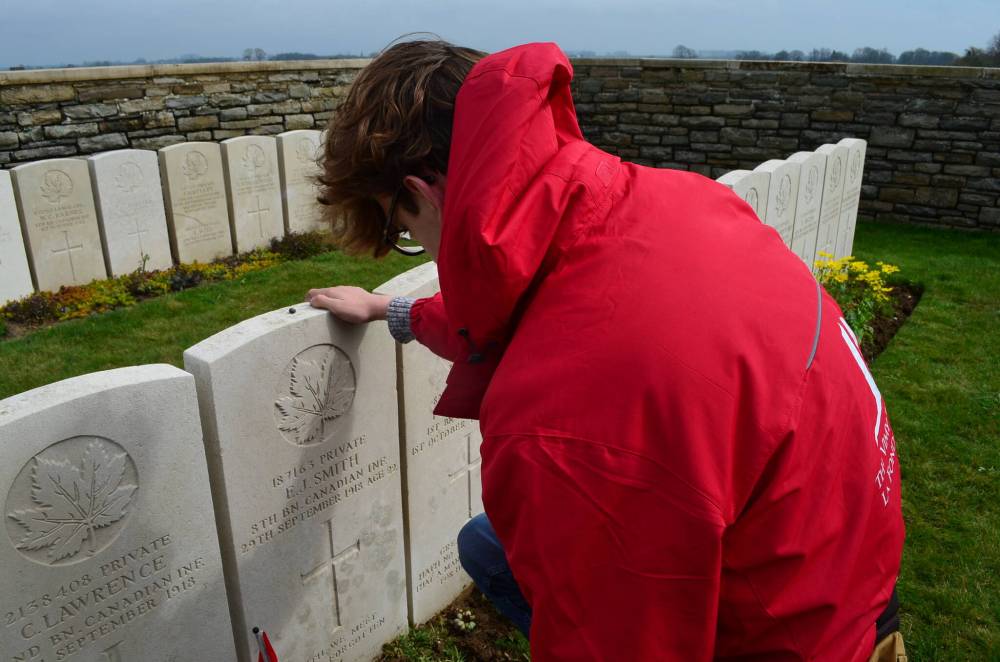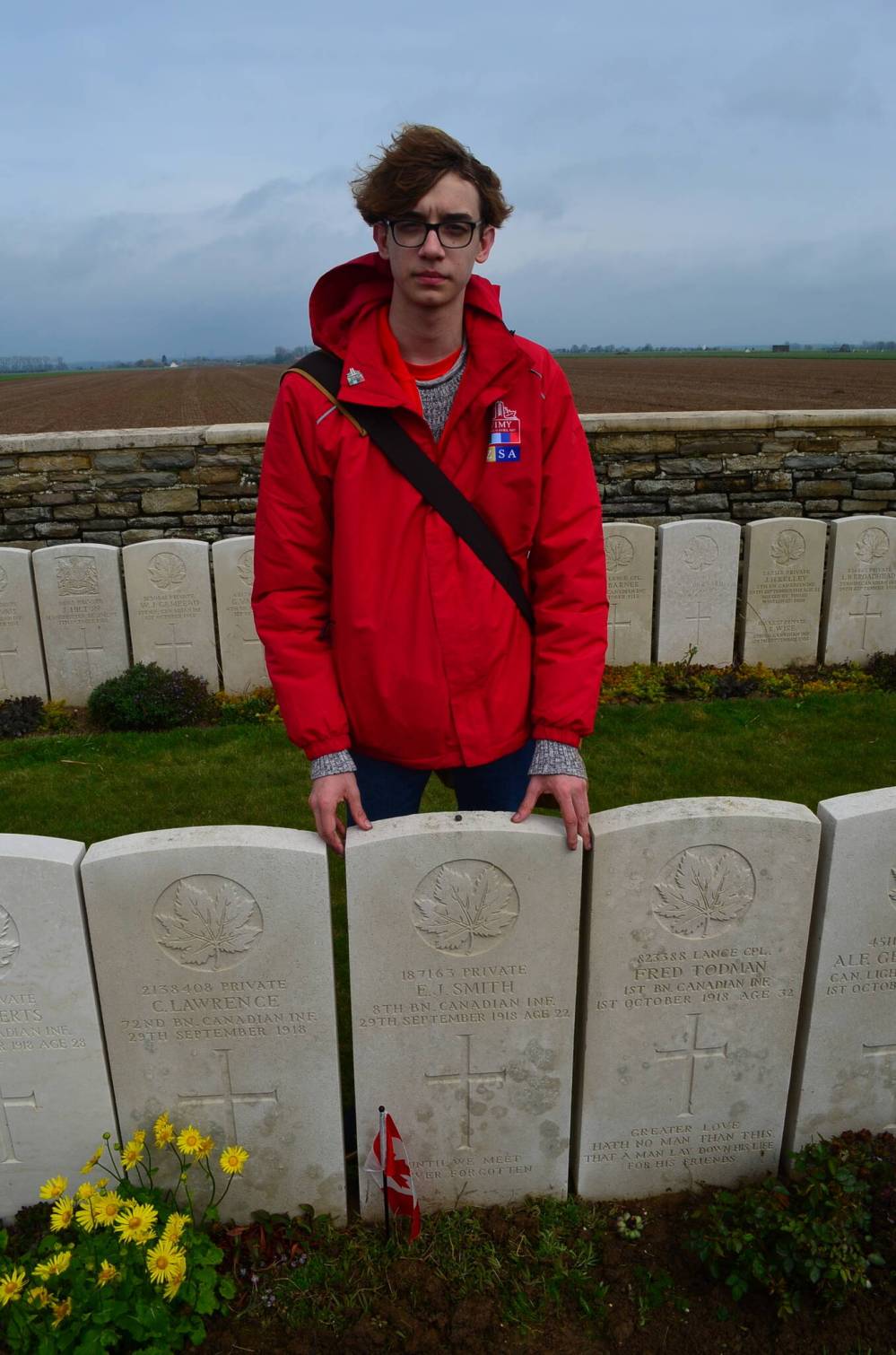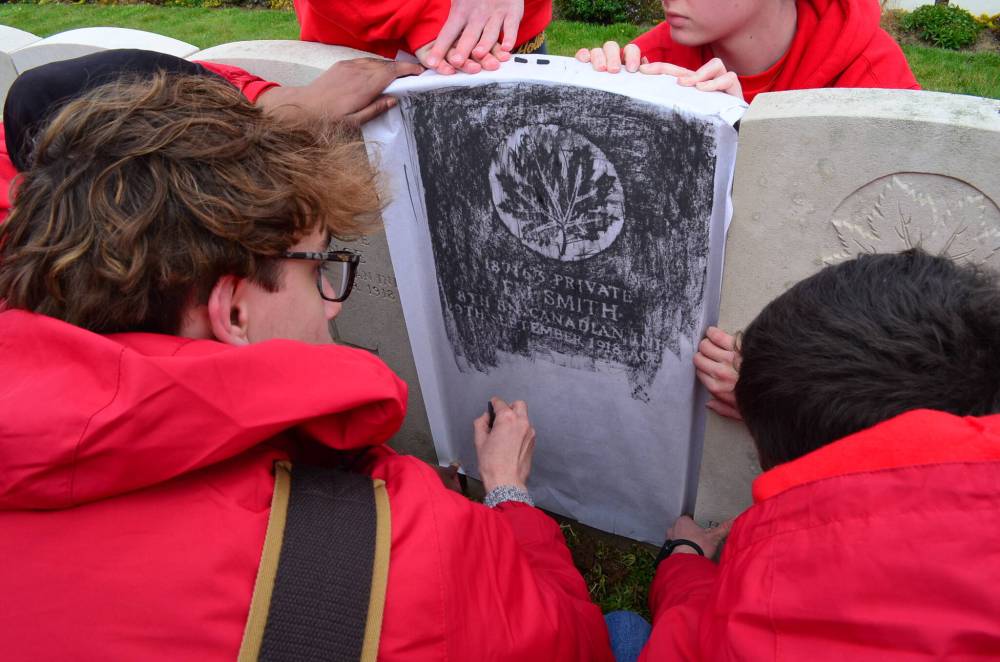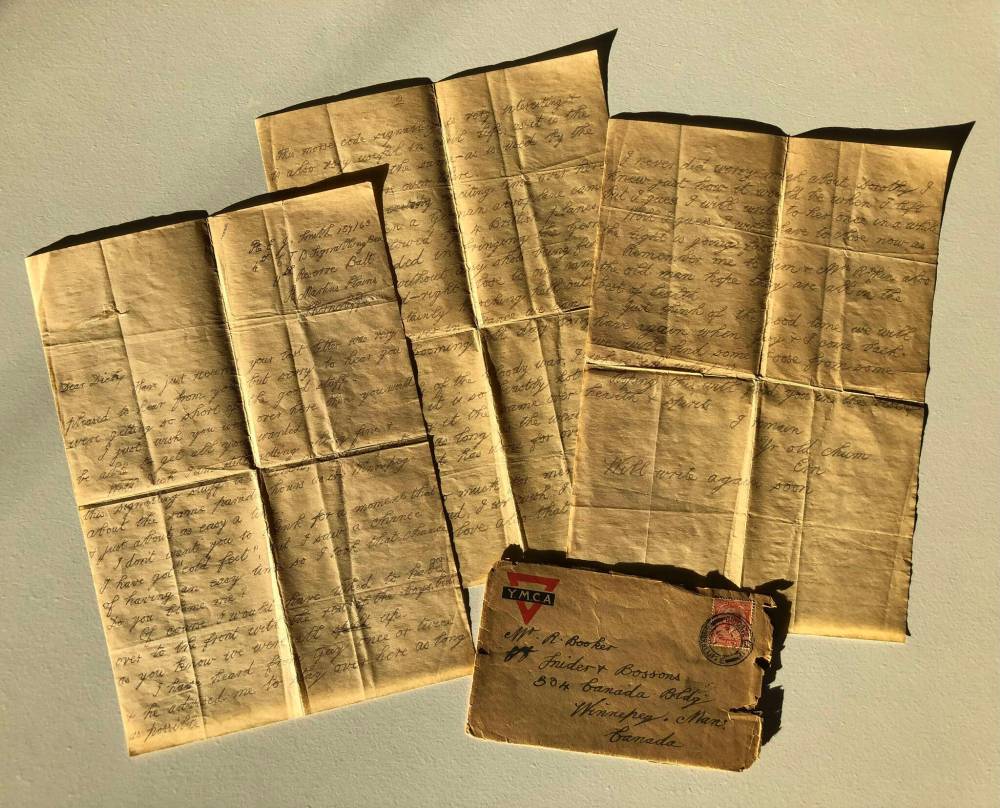Student honours fallen soldier on Vimy pilgrimage
Pebble placed on gravestone ‘a piece of the home that he never came back to’
Advertisement
Read this article for free:
or
Already have an account? Log in here »
To continue reading, please subscribe:
Monthly Digital Subscription
$0 for the first 4 weeks*
- Enjoy unlimited reading on winnipegfreepress.com
- Read the E-Edition, our digital replica newspaper
- Access News Break, our award-winning app
- Play interactive puzzles
*No charge for 4 weeks then price increases to the regular rate of $19.00 plus GST every four weeks. Offer available to new and qualified returning subscribers only. Cancel any time.
Monthly Digital Subscription
$4.75/week*
- Enjoy unlimited reading on winnipegfreepress.com
- Read the E-Edition, our digital replica newspaper
- Access News Break, our award-winning app
- Play interactive puzzles
*Billed as $19 plus GST every four weeks. Cancel any time.
To continue reading, please subscribe:
Add Free Press access to your Brandon Sun subscription for only an additional
$1 for the first 4 weeks*
*Your next subscription payment will increase by $1.00 and you will be charged $16.99 plus GST for four weeks. After four weeks, your payment will increase to $23.99 plus GST every four weeks.
Read unlimited articles for free today:
or
Already have an account? Log in here »
Hey there, time traveller!
This article was published 08/04/2023 (972 days ago), so information in it may no longer be current.
Aidan Nowicki took a moment to himself as he laid a pebble atop the gravestone of a Canadian soldier killed in Europe during the First World War.
Private Ernest James Smith, had lived not far from Nowicki’s grandmother’s home in Winnipeg, and the Shaftesbury High School student travelled roughly 7,000 kilometres to the Sancourt British Cemetery in Nord, France, to honour him.
“I placed it on top of the headstone just to give him, in a way, a piece of the home that he never came back to. It was very saddening to the heart,” Nowicki said, speaking from France by phone Saturday.

SUPPLIED
Aidan Nowicki visited the Sancourt British Cemetery in Nord, France on April 6, to lay a pebble on the gravesite of Private Ernest James Smith. The rock came from Smith’s family home in Winnipeg.
Nowicki, 17, landed in Europe last week alongside 21 of his peers. The group is part of a Canadian youth delegation, touring the continent’s cemeteries, memorials and battlegrounds in anticipation of the anniversary of the Battle of Vimy Ridge.
Sunday marks the 106th year since an estimated 3,600 Canadians were killed and twice as many were wounded on the battlefield in northern France. The battle was the first in which Canadians from coast to coast fought together against a common enemy.
Vimy Ridge Day has been observed as a non-statutory holiday in Canada since 2003.
The Vimy Foundation organizes an annual pilgrimage to Belgium and France, offering Canadian teens the opportunity to observe, honour and reflect on the war.
Nowicki’s interest in military history spans back to his childhood, when his favourite toys were plastic green army men, and his crayon scribblings depicted Napoleonic soldiers dressed in their distinctive red coats.
The trip has left him wrought with awe, grief and reverence for the millions of soldiers impacted during the First World War. He felt especially drawn to Smith, who was just 22-years-old when he was killed in battle.
“When I look at the graves of Manitobans, it makes me realize this guy was a local boy, coming from Winnipeg or a small town in Manitoba,” he said. “The heaviness comes with the realization that (the number of people who died) are not just statistics. Each one represents an individual and his family.”
A letter, penned by Smith during the war and gifted to Nowicki from a collector in France, sparked months of research into the fallen soldier’s life and military career. In it, Smith details his desire to return home and his aspirations beyond the war.

SUPPLIED
Aidan Nowicki visited the Sancourt British Cemetery in Nord, France on April 6, to lay a pebble on the gravesite of Private Ernest James Smith. The rock came from Smith’s family home in Winnipeg.
“We can hear the big guns booming all day long over here,” Smith wrote. “Remember me.”
“I could not stop thinking of him. His letter was so significant in the way that it shows the true humanity of the conflict. He often wrote home that he wanted to come back one day, which he never did,” Nowicki said. “It’s daunting.”
In anticipation of his visit to the gravesite, Nowicki delved further into historical and genealogical records to piece together Smith’s journey from Canada to war-torn Europe. He even visited the family home, which still stands at 210 Whytwold St. in the Silver Heights neighbourhood.
There he retrieved the pebble to lay on Smith’s grave.
According to Nowicki’s research, Smith was an English immigrant who settled in Winnipeg with his parents and siblings around 1912.
Three years later, he enlisted with the Canadian Expeditionary Force. The military assigned him to the 90th Battalion, also known as the Winnipeg Rifles. He completed basic training in Manitoba and landed in back in Europe the following year.
Then around 20 years old, Smith specialized in signalling, a role that involved co-ordinating force movements, distributing intelligence and operating telegram systems.
In 1917, he found himself on the front lines with the 8th Battalion, also called the Little Black Devils. The troop engaged in numerous operations in France, including the battle for Hill 70 near Lens, and at Passchendaele.

SUPPLIED
Aidan Nowicki uses a piece of carbon to create a copy of Private Ernest James Smith’s gravestone at the Sancourt British Cemetery in Nord, France on April 6.
According to military records, Smith was killed in action Sept. 29, 1918.
“Knowing that he never came back, reading his letter saying he wants to come home always hits me,” Nowicki said. “Commemoration is an act of forgiveness, in a way. We have to forgive others, and ourselves, and never forget what wars can do to people.”
The Vimy Foundation established its Vimy Pilgrimage Award program in 2013 and has since sent more than 150 students to Europe.
Sean Graham, the foundation’s educational lead, said the trips often have a profound affect on teens.
“It goes beyond just the facts and the numbers. It is something you see in the kids, they change all the time,” Graham said by phone.
In addition to visiting historical sites, students view lectures and participate in discussions about the global, economic and social impacts of warfare. While much of the content is viewed through a historical lens, it can inform their perspectives on modern, global affairs, he said.
“It was very much a global conflict in every sense and we can find themes of that today,” Graham said. “The humanity involved is universal and it matters.”
The pilgrimage is held annually in the first week of April. It is free and open to all Canadian students who complete the application process.

SUPPLIED
Private Ernest James Smith penned this letter to a friend 107 years ago while fighting in the First World War. It ended up in the hands of a French collector who passed it along to Aidan Nowicki, inspiring him to research Smith’s life and career.
More information is available online at http://wfp.to/0O1
Nowicki will graduate high school in June and plans to pursue a degree in philosophy before applying to law school.
He hopes to return to European battlefields in the future, possibly as a tour guide for others interested in learning the history of the Great War, he said.
tyler.searle@freepress.mb.ca

Tyler Searle is a multimedia producer who writes for the Free Press’s city desk. A graduate of Red River College Polytechnic’s creative communications program, he wrote for the Stonewall Teulon Tribune, Selkirk Record and Express Weekly News before joining the paper in 2022. Read more about Tyler.
Every piece of reporting Tyler produces is reviewed by an editing team before it is posted online or published in print — part of the Free Press‘s tradition, since 1872, of producing reliable independent journalism. Read more about Free Press’s history and mandate, and learn how our newsroom operates.
Our newsroom depends on a growing audience of readers to power our journalism. If you are not a paid reader, please consider becoming a subscriber.
Our newsroom depends on its audience of readers to power our journalism. Thank you for your support.


